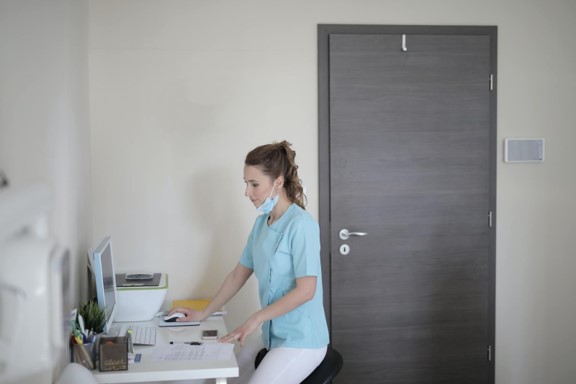EHR vs EMR vs EMAR - Understand the Differences

Healthcare professionals love abbreviations and acronyms. In senior living communities and other organizations, everything from the names of disorders to medical tests gets shortened into a string of letters. But this alphabet soup can make it difficult to distinguish between similar-sounding tools, especially if you’re shopping for new software. You may wonder, what is the difference between an EHR, an EMR, and an EMAR?
All three terms are abbreviations for different types of electronic records commonly found in the healthcare industry. Senior living communities use this technology to store data about residents’ health histories and treatments. However, each type of record has unique advantages and functions. Understanding the differences between EHR, EMR, and EMAR can help you select the right system for your organization.
What is an EHR?
EHR stands for electronic health record. This digital file collects detailed descriptions of a resident’s medical history. An EHR contains valuable information like:
- Allergies
- Diagnoses
- Hospital discharge instructions
- Immunization records
- Laboratory reports
- Medical treatments
- Prescriptions
- Progress reports
- Resident headshots
Healthcare providers maintain EHRs and send them to other authorized users over secured networks. This feature lets all care team members stay in the loop about a resident’s medical needs. For example, a cardiologist can update a resident’s EHR with a new diagnosis of coronary heart disease. The EHR system transmits the treatment plan to the individual’s primary care provider and assisted living community. Based on this data, the senior living team ensures that the resident attends follow-up appointments and receives the proper medication.
Other features of EHRs include:
Accurate Records
Many people struggle to fully retain information during a doctor’s appointment, especially if they’ve just received a new diagnosis or medication. Thanks to EHRs, you won’t have to rely on a resident to remember if they have arrhythmia or erythema. Instead, you can verify the information in the EHR system.
Automation
Busy senior living professionals juggle dozens of tasks throughout their shifts. An EHR system reduces mental load and saves time by automating repetitive administrative processes. For example, this software can automatically generate an invoice after a resident receives services and pull forward previous notes so that staff members don’t need to retype unchanged data.
Customization
Senior living organizations can tailor EHR software to fit their unique needs. Develop a custom intake chart to gather information during move-ins or simplify note templates to streamline workflows.
Resident Access
EHR systems often have resident portals for seniors and authorized family members. This convenient feature allows residents to review their health records, message their providers, and update insurance information. Plus, staff can spend less time digging up medical charts to remind residents of their doctors’ dietary instructions or returning phone calls from family members who want to check if their parents have gotten their flu vaccines.
What Is an EMR?
EMR is short for electronic medical records. Like EHRs, EMRs store residents’ financial and health data. For instance, senior living professionals use these digital files to record allergies, dietary restrictions, insurance information, and treatment plans.
However, EMRs have a more limited scope than EHRs. These records belong to a single healthcare provider or organization. So, they don’t consolidate medical information across networks. They also don’t transfer between providers or get shared with patients.
As a result, EMRs could cause providers to miss vital details from a resident’s medical history or accidentally duplicate services. For instance, an assisted living community may not realize that a resident has developed a new health condition or medication allergy if this information is locked away in a doctor’s private EMR system.
So why do some organizations choose EMRs? These records have a few advantages over EHRs, including:
Greater Security
EMRs are less vulnerable to cybercrime because they don’t travel digitally between healthcare organizations. That means providers can feel more confident that residents’ confidential data won’t get stolen and used for nefarious purposes.
Personalized Formatting
EHRs must be standardized to make them easily shareable across healthcare networks and providers, but EMRs don’t have this limitation. Providers can format EMRs to suit their preferences without making the data legible or transferable to external healthcare professionals.
What Is an EMAR?
EMAR is an acronym for electronic medication administration records. This software gathers data about each resident’s medications and automatically updates their records when providers prescribe new drugs or adjust existing dosages. EMARs also track when seniors receive medication, ensuring that every resident receives the correct medication on the proper schedule.
Key features of EMAR include:
Interoperability
Senior living communities can integrate EMAR with EHR. So, professionals don’t need to waste time maintaining two separate systems for resident data.
Inventory Tracking
EMAR software monitors the amount of medication assisted living communities have on hand and automatically sends refill requests to the pharmacy when supplies run low. This tool eliminates the moment of panic that senior living staff feel when they discover that a resident has run out of a vitally important medicine — often at an inconvenient time, like during a holiday or weekend.
Push Notifications
Many seniors have complex and frequently changing medication regimens. Some residents may take over a dozen medications over a single day. Multiply that number by dozens or hundreds of residents, and it’s easy to see how stressed-out staff could forget to administer a dosage here or there. Fortunately, EMAR prevents medication errors by sending push notifications to remind staff of missed dosages so that they can immediately fix their mistake.
Choosing Between EHR, EMR, and EMAR
Assisted living professionals have dozens of innovative tools at their fingertips. However, it can be hard to know which software works best for your organization — especially if you don’t have a huge budget to try out every product. Knowing how to distinguish between EHR, EMR, and EMAR can help you choose the ideal system for patient records.
In summary, EHR might be perfect for you if you:
- Need to exchange health records with providers seamlessly
- Want to automate tasks to ease your staff’s workload
- Value resident access to data
Meanwhile, you could consider EMR if you:
- Only need to share data privately within your organization
- Enjoy the flexibility of non-standardized record
EMAR can supplement EHR or EMR and provides these excellent benefits:
- Automatic medication refills
- Dosage scheduling and push notifications
If you’re ready to explore your options further, a senior living software vendor like Med e-care can help you find the best records solution for your community. So, you can spend less time at your keyboard and more time providing excellent care for residents.
Would you like to learn more about how Med e-care can help you?





